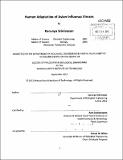Human adaptation of avian influenza viruses
Author(s)
Srinivasan, Karunya
DownloadFull printable version (12.38Mb)
Other Contributors
Massachusetts Institute of Technology. Dept. of Biological Engineering.
Advisor
Ram Sasisekharan.
Terms of use
Metadata
Show full item recordAbstract
Human adaptation of avian influenza viruses pose an enormous public health challenge as the human population is predominantly naive to avian influenza antigens. As such, constant surveillance is needed to monitor the circulating avian strains. Of particular importance are strains belonging to H5N1, H7N7, H7N2 and H9N2 subtypes that continue to circulate in birds worldwide and have on occasions caused infections in humans. A key step in influenza human adaptation is the accumulation of substitutions/mutations in the viral coat glycoprotein, hemagglutinin (HA), that changes HA's binding specificity and affinity towards glycan receptors in the upper respiratory epithelia (referred to as human receptors). Unlike for the H1, H2, H3 and more recently H5 HA a correlation between the quantitative binding of HA to human receptors and respiratory droplet transmissibility has not been established for H9 and H7 subtypes. This thesis is a systematic investigation of determinants that mediate changes in HA-glycan receptor binding specificity, with focus on the molecular environments within and surrounding the glycan receptor binding site (RBS) of avian HAs, particularly the H9 and H7 subtypes. The glycan receptor binding properties of HA were studied using a combination of biochemical and molecular biology approaches including dose dependent glycan binding, human tissue staining and structural modeling. Using these complementary analyses, it is shown that molecular interactions between amino acids in and proximal to the RBS, including interactions between the RBS and the glycan receptor converge to provide high affinity binding of avian HA to human receptors. For the H9 HA [alpha]2-->6 glycan receptor-binding affinity of a mutant carrying Thr-189-->Ala amino acid change correlated with the respiratory droplet transmission in ferrets conferred by this change. Further, it was demonstrated for the first time that two specific mutations; Gln226-->Leu and Gly228-->Ser in glycan receptor-binding site of H7 HA substantially increase its binding affinity to human receptors. These approaches and findings contribute to a framework for monitoring the evolution of HA and the development of general rules that govern human adaption applicable to strains beyond ones currently under study.
Description
Thesis (Ph. D.)--Massachusetts Institute of Technology, Dept. of Biological Engineering, 2012. Cataloged from PDF version of thesis. Includes bibliographical references.
Date issued
2012Department
Massachusetts Institute of Technology. Department of Biological EngineeringPublisher
Massachusetts Institute of Technology
Keywords
Biological Engineering.